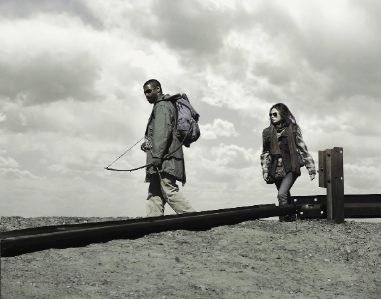The Book of Eli

As soon as you hear the title, you can probably guess what kind of film The Book of Eli is going to be. Yes, it is the story about a man named Eli (played by Denzel Washington, who is also one of the film’s producers), who has a book; it is also about the Bible, which in this case seems to provide not a set of beliefs but simply the hope that humanity has a future.
The film plays out in a postapocalyptic wasteland that will look familiar to fans of the Mad Max trilogy. Like the protagonist in those films, Eli must fight off a slew of sleazy killers, thieves and rapists who, like Eli, have survived the nuclear holocaust that occurred 30 years earlier. Eli’s mission, given to him by a voice in his head, is to move west with the book, which is supposedly the last copy on Earth. (The other copies were destroyed in anger when religion was blamed for the planet’s destruction—a theme the film doesn’t explore as deeply as it might.)
The Book of Eli is an old-fashioned western dressed up in postapocalyptic rags. Eli is the “man with one name” who ambles into a backwater burg in search of water and comes face to face with evil in the form of Carnegie (Gary Oldman), who is involved with the blind Claudia (Jennifer Beals) while he pursues Claudia’s nubile daughter Solara (Mila Kunis).(There are some allusions here to the biblical story of Herod and his daughter.)
What Carnegie wants even more than women, however, is a copy of the Bible, since he is old enough to remember how powerful the book can be. He breaks all sorts of commandments in a desperate attempt to get it from Eli.
What makes The Book of Eli a cut above most religiously tinted westerns is the visual style and elan of the Hughes Brothers (the name Albert and Allen Hughes work under), makers of Menace II Society and From Hell. Almost all of the action sequences—and there are plenty of them—are beautifully staged and creatively shot by cinematographer Don Burgess. My favorite one is of Eli’s first encounter on the road, which shows he is a man to be reckoned with. The scene features severed limbs and spurting blood, but it is shot as a gorgeous silhouette at the end of a long tunnel, combining elements of shadow puppetry and Kabuki theater.
Later, Eli encounters a couple of eccentric cannibals (are there any other kind?) named George and Martha, played with over-the-top giddiness by esteemed British thespians Michael Gambon and Frances de la Tour. Though they make their exit from the film with the sound of bullets ripping through flesh, the entire sequence is astounding. The filmmakers employ almost every form of natural light they can conjure up, including sunlight flashing through bullet holes in the walls, to paint and frame George and Martha’s demise.
The third act, in which Eli reaches the west, borrows so many story lines from other filmmakers (including, amazingly enough, François Truffaut) that it puts Quentin Tarantino to shame. But by that point, the film has enough power to make you forgive the clichés.
Washington is, as usual, solid in his role. Oldman looks like he is having fun as the baddie, as does solid character actor Ray Stevenson as his sort-of-trusted enforcer.
The Book of Eli does not have the spiritual gusto of a Bergman movie, but for an action movie it does make you think about the power of the word in a world where words have started to disappear.




